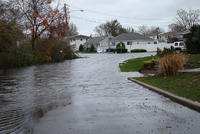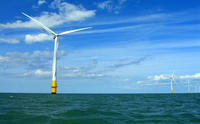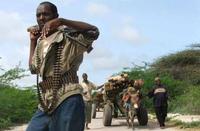-
Haiti's food situation looks bleak in Sandy’s aftermath
The aftermath of Hurricane Sandy, which ripped through southern Haiti in October, will extend beyond destruction and injury; the current and future food security looks bleak barring significant intervention during the next year
-
-
Social networks helping during disasters
In 2005, when Katrina hit New Orleans, social networking Web sites were not as popular or as informative as they are today. Facebook was only up for a year at that point and was still restricted to college students only; Twitter was not started until 2006, and most local governments did not use the Internet for daily updates and information; advancements in social networking Web sites and in technology made a big difference for victims of Sandy
-
-
Conviction of Italian seismologists has others in the field rethinking speaking out
After six Italian scientists were sentenced to six years in prison for failing to warn citizens of an earthquake in 2009, the scientific community has been forced scared into rethinking predictions and risk in order to avoid possible jail terms
-
-
To keep global average temperature from rising above 2°C, action should be taken by 2020
Limiting climate change to target levels will become much more difficult to achieve, and more expensive, if action is not taken soon, according to a new analysis; a new study explores technological, policy, and social changes that would need to take place in the near term in order to keep global average temperature from rising above 2°C, a target supported by more than 190 countries as a global limit to avoid dangerous climate change
-
-
New view of meteorite impact
High-speed video of projectiles slamming into a bed of disks has given scientists a new microscopic picture of the way a meteorite or missile transfers the energy of its impact to sand and dirt grains; the research may change the way scientists model meteorite and missile impacts and their effects
-
-
Insurance industry paying increasing attention to climate change-related risks

The insurance industry, the world’s largest business with $4.6 trillion in revenues, is making larger efforts to manage climate change-related risks, according to a new study; weather- and climate-related insurance losses today average $50 billion a year; these losses have more than doubled each decade since the 1980s, adjusted for inflation
-
-
Sandy exposes weaknesses of antiquated sewage systems in N.Y., N.J.

Hurricane Sandy destroyed homes, apartments, and entire communities, and it also exposed the outdated sewage systems in New York and New Jersey; since Hurricane Sandy, millions of gallons of raw sewage have infiltrated waterways in both states, and it could take several years and billions of dollars to fix the systems; New York governor Andrew Cuomo estimated that it will cost about $1.1 billion to repair treatment plants; officials in the field say that much more will have to be done
-
-
Engineers to build Australia’s first bushfire resistant straw house
With Australia’s bushfire season fast approaching, construction of the first bushfire resistant straw bale house tested by engineers from CSIRO has begun in rural Victoria; the house is based on design principles that minimize environmental impact and it is set to withstand temperatures equal to that of a worst case bushfire scenario
-
-
Helping communities resist wildfires

In the ten years since 2002, an annual average of nearly 71,000 wildfires near structures and other human development were recorded and 1.9 million hectares (4.7 million acres) burned; federal agencies spend an average of $1.2 billion per year on the suppression of these fires, with state and local agencies contributing millions more
-
-
City officials debate proposals for sea walls to protect New York from storms
Since Hurricane Sandy ripped through the northeast, many people have had to decide what to do with their damaged homes; now elected officials in New York must decide how to protect coastal areas around the city from being run over by storms in the future; New York officials are now proposing similar projects, including a $16 billion barrier for New York Bay, which was proposed by City Council president Christie Quinn
-
-
Improved research tools helped predict impact of last week’s Japan earthquake
On 11 March 2011, a magnitude-9.0 earthquake and ensuing tsunami that slammed into northeastern Japan killed or left missing some 19,000 people, devastating much of the coast; lessons were learned, and improved computational models helped in more accurately predicting the impact of a strong earthquake near Japan last Friday
-
-
Testing new wind energy turbine

An offshore wind test turbine has been erected behind the University of Maine Advanced Structures and Composites Center on campus to evaluate sensor systems and controls in preparation for the installation of a floating turbine in the Gulf of Maine this spring as part of the DeepCwind Consortium project
-
-
U.S. intelligence forecast: growing interstate conflicts over food, water

The U.S. National Intelligence Council, the research arm of the Office of the Director of National Intelligence, yesterday released its Global Trends 2030; the report’s authors say that food, water, and energy will be more scarce; “Nearly half of the world’s population will live in areas experiencing severe water stress,” the report notes; Africa and the Middle East will be most at risk of food and water shortages, with China and India also vulnerable; one bright spot for the United States: energy independence sometime between 2020 and 2030
-
-
Climate models still struggle with medium- term climate forecasts
Scientists have evaluated twenty-three climate models and concluded that there is still a long way to go before reliable regional predictions can be made on seasonal to decadal time scales; none of the models evaluated is able today to forecast the weather-determining patterns of high and low pressure areas such that the probability of a cold winter or a dry summer can be reliably predicted
-
-
Geologists pinpoint powerful-earthquake hot spots
After studying about 1,500 earthquakes, scientists conclude that the world’s largest earthquakes occur at subduction zones — locations where a tectonic plate slips under another; the scientists have found that regions where “scars” on the seafloor, called fracture zones, meet subduction areas are at higher risk of generating powerful earthquakes
-
More headlines
The long view
Using Drone Swarms to Fight Forest Fires
Forest fires are becoming increasingly catastrophic across the world, accelerated by climate change. Researchers are using multiple swarms of drones to tackle natural disasters like forest fires.
How Climate Change Will Affect Conflict and U.S. Military Operations
“People talk about climate change as a threat multiplier,” said Karen Sudkamp, an associate director of the Infrastructure, Immigration, and Security Operations Program within the RAND Homeland Security Research Division. “But at what point do we need to start talking about the threat multiplier actually becoming a significant threat all its own?”
